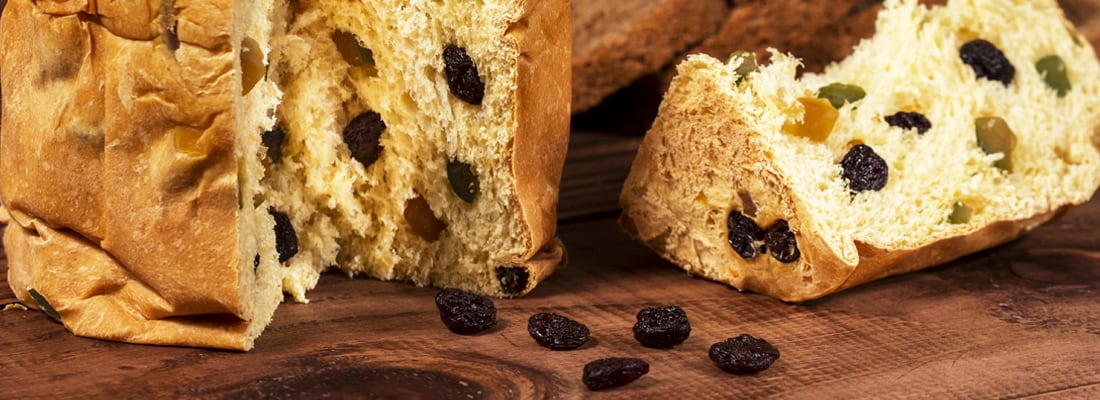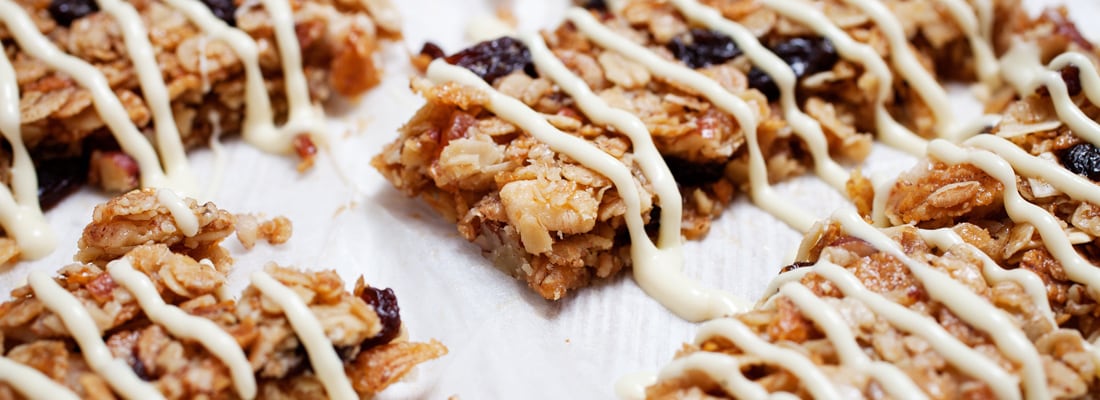PROFESSIONAL TIPS
Professional Baking
California Raisins, a very traditional ingredient, are perfectly on-trend in the baking category for those consumers who want a wholly natural product. The ingredient list says it all: Raisins. Naturally dried in the sun and aside from a thorough washing and removal of stems, California Raisins can move from the field to your baked goods. Want to go green? Choose California Raisins.

BAKING
Conditioning
California Raisins have approximately 1,750 to 2,650 berries per kg in select size (1,000 to 1,200 berries per pound). Raisins can be used right out of the case, but experienced bakers commonly condition raisins in advance. This involves re-hydrating raisins to the desired moisture level. Conditioning is an important step in the production of raisin breads. If raisins are not conditioned but added directly to the dough, they will draw moisture from the bread during fermentation and baking. This also causes the bread to stale during shipping and distribution, which reduces the shelf life.
For small quantities, the American Society of Bakery Engineers recommends that quantities of not more than 30 lbs be conditioned by adding 12 to 15 percent of warm water by weight to the raisins right in the case. Temperature of the water should not exceed 75° to 80°F and 3.6 to 4.5 lbs of water to 30 lbs of raisins. Re-close the poly-liner, cover the container, and turn it a number of times to distribute the water uniformly. Turn again after about 2 hours and allow to stand for an additional 2 hours for a total conditioning time of at least 4 hours or overnight. Longer periods may over condition and release more solids from the raisins. Any remaining liquid should be added to the dough as part of the liquid component in the formula. Do not condition raisins in excessively hot water. For best results, raisins should be about 75°F at the end of the process.
For larger quantities, the American Institute of Baking recommends that raisins be placed in a trough or tank with a screened bottom opening for draining the water. Completely cover the raisins with water at 75° to 80°F and then, drain. Close the drain to retain leached solids and cover the trough or tank and allow the raisins to absorb the surface water for at least 4 hours or overnight. Longer periods may over condition and release more solids from the raisins. Any remaining liquid should be added to the dough as part of the liquid component in the formula. Do not condition raisins in excessively hot water. For best results, raisins should be about 75°F at the end of the process.

BAKING
Purchasing
The Right Raisin for the product – California Seedless Raisins are available in a variety of sizes appropriate for bakers. These include mini small raisins, small raisins, select raisins, and jumbo raisins. Different packers have different terms to describe size but, for the most part, California Raisins are sized either by count per lb or kilo or by screen size. Specify screen size if a special size is important and integration throughout the product is required. Golden raisins, Zante currants and other dried grape varieties are also available for specialized applications.
California Raisins are shipped in poly-lined boxes. They are available in bulk packages of 13.6 kg (30 lbs) and other size cartons. This is ideal for purchase by a full container load of approximately 17 metric tons per 20-foot container, where 1,250 to 1,800 cases may be loaded depending on the carton size. California Raisins are available in a variety of snack and consumer packs, too. Most bakers purchase California Raisins in 25 or 30-lbs cases.
BAKING
Preparation Information
California Raisins are shelf stable and require no preparation, ready to go, right out of the package.
For some preparations, however, better results may be obtained by reconstituting or “plumping” them. This process allows moisture to enter through the skin to soften the texture and add juiciness to the raisin. There are several ways to do this.
Soak them in the liquid part of the batter in which they are to be cooked, such as the liquid called for in cakes or breads, for 10 to 15 minutes. Drain and add liquid as directed in the recipe and then stir in raisins as indicated.
Pour hot tap water over the raisins just to cover plus just a little extra and let stand up to 5 minutes or until the fruit is plump and juicy. If any excess water is to be discarded, do not soak more than 5 minutes to prevent loss of flavor and nutrients.
Rinse and quickly drain the raisins and spread in a single layer onto a baking sheet. Then, cover tightly with foil and heat in a 350°F oven until they puff up and are no longer wrinkled.
Raisins may also be covered with water; heated and simmered until all the liquid is absorbed or evaporated. Cool these before adding to batters or dough.
Sometimes, raisins are infused with flavors by soaking in fruit juices, liqueurs or flavored syrups. Most recipes will specify that these be soaked for several hours or overnight and excess liquid is added to the preparation along with the plumped raisins to enhance the desired flavor as well as to preserve nutrients.
To chop raisins, use a lightly oiled knife or blade to prevent sticking.
When preparing batters and dough, dredging the raisins in a small amount of flour will keep them from sinking to the bottom of the pan. Do not condition raisins in excessively hot water. For best results, raisins should be about 75°F at the end of the process.
Soak them in the liquid part of the batter in which they are to be cooked, such as the liquid called for in cakes or breads, for 10 to 15 minutes. Drain and add liquid as directed in the recipe and then stir in raisins as indicated.
Pour hot tap water over the raisins just to cover plus just a little extra and let stand up to 5 minutes or until the fruit is plump and juicy. If any excess water is to be discarded, do not soak more than 5 minutes to prevent loss of flavor and nutrients.
Rinse and quickly drain the raisins and spread in a single layer onto a baking sheet. Then, cover tightly with foil and heat in a 350°F oven until they puff up and are no longer wrinkled.
Raisins may also be covered with water; heated and simmered until all the liquid is absorbed or evaporated. Cool these before adding to batters or dough.
Sometimes, raisins are infused with flavors by soaking in fruit juices, liqueurs or flavored syrups. Most recipes will specify that these be soaked for several hours or overnight and excess liquid is added to the preparation along with the plumped raisins to enhance the desired flavor as well as to preserve nutrients.
To chop raisins, use a lightly oiled knife or blade to prevent sticking.
When preparing batters and dough, dredging the raisins in a small amount of flour will keep them from sinking to the bottom of the pan. Do not condition raisins in excessively hot water. For best results, raisins should be about 75°F at the end of the process.
BAKING
FAQs
Normally, this is caused by excessive soaking of the raisins. You need to keep the structure of the raisin intact so properly conditioned raisins are essential for quality baked goods.
Excess free sugar and acid in the dough resulting from crushed fruit or broken skins during the mixing is frequently the cause. Mix the raisins in gently to maintain the integrity and wholeness of the raisin. Excessive amounts of cinnamon in bread may also be a cause of uneven fermentation.
Excessive oven temperature is the most common cause. Raisin dough products are best when baked at lower temperatures than conventional breads. A reduction of 25 degrees or more seems to work best. Low pressure steam in the oven will also help eliminate charred raisins.
Add the raisins at the very last step, during the last minute or two of the mixing process to ensure that the fruit remains intact.
CALIFORNIA RAISINS
Social Media
Find us on our social media network.
